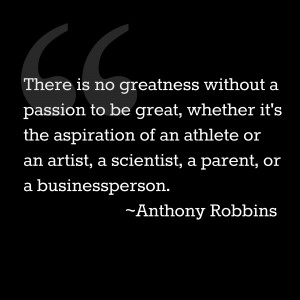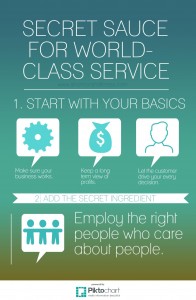I Asked Leaders What They Do to Stay Motivated – Here Are the Top 5 Responses:
Leadership
I once had a boss named Allison who was incredibly energizing. Talking to her was like plugging into an electric socket. When she talked to you, it was like you were the only person in the world. She never made it seem like an impromptu knock on her door was an interruption. Even though I knew she had a full schedule, she would drop everything to have a conversation and would make me feel like she was truly listening and that what I had to say was important. I was no one special; she treated everyone this way. If she had a free moment she would make her rounds in the office and it seemed she would attract a small crowd everywhere she went. She would tell funny stories and would encourage others to do the same. Whether we were talking about something work-related or telling a personal story was inconsequential. Any interaction with her was one where you felt important, you felt like you were part of a winning team, and you felt motivated.
When I became a manager, I no longer had an Allison around to energize me. It was just me. Not only was I missing my energy source, but I felt the responsibility of being that revitalizing force for my team that Allison had been for me. This sent me on my quest to find out how I could be an energy source for the people around me.
Where does a leader get their energy to rally their team? Over the years, I asked this question of people in leadership roles, from leaders in small companies right up to Fortune 10 leaders. Here is a sampling of the top responses I collected from leaders on how they kept their energy at an optimal level:
- Keep yourself in check with a daily question: “What did I do to earn my paycheck and add value?” This one question holds you accountable to producing results. If you can’t answer this question on a given day, find something outside the box that adds value. This could be setting the wheels in motion towards a goal you had previously put on the back-burner, generating a new idea, or strengthening a relationship with a key colleague or client—anything that helps to advance your work.
- Keep your eyes 6 months ahead. When feeling bogged down in some of the less exciting aspects of their role, some leaders opt to remind themselves to take the long-term view. Reminding yourself of your big-picture objectives keeps you from getting mired in the temporary drudgery of short-term tasks that lower your energy. The practice of reminding yourself daily of how you are moving closer to achieving your goals helps to reveal the big-picture meaning in every day.
- Diversify what you’re involved in so you can constantly be doing something that shows results. Every job, even at the highest levels, can have potholes that veer things off course. And getting caught in the weeds can be discouraging, particularly if you are spending large amounts of time on things that take a long time to show value. Diversifying your areas of focus keeps things changing so you can come back to key tasks with fresh eyes and renewed enthusiasm. Some leaders build time into their day to step away to go for a run, to be involved in a charity or even to just walk around and have casual conversation with people. Afterwards they come back to ongoing priorities with new energy and a fresh perspective.
- Expect to work outside of your comfort zone. Living outside of your comfort zone will challenge you on a daily basis because it forces you to do things that you would not normally do. For instance, if you are an introvert, maybe you challenge yourself to initiate conversation with someone new each day. While this may seem exhausting on the surface, what it actually does is it conditions you to become more dynamic and flexible. This way, the things that used to drain your energy are now more of a conscious habit. Once this is your baseline, you will constantly extend yourself beyond your default, and this practice can take you places you never would normally go.
- Have your own personal board of advisers. Many leaders find it energizing to surround themselves with mentors, work colleagues, and friends who challenge and inspire them. These are people they trust with whom they can share challenges, solve problems, and learn. Building relationships like this helps to harness the experience of others and to gain insight from people with a different perspective. These people become your cheerleaders as they encourage and challenge you.
What I learned from asking leaders how they stay energized is that the answer is not the same for everyone–each leader had a different way to keep their energy high. So the key for any leader is that you first need to know the answer to the question, “what energizes you?” Because knowing your answer to this question helps to make you the electrical socket for your team. And when it comes to achieving your goals, in the words of Emerson, “enthusiasm is one of the most powerful engines of success.”
How about you? What strategies have you used to keep yourself energized?
For a little inspiration right in your inbox, leave your email below and we’ll drop you a line. Thanks for reading!
[wysija_form id=”2″]




 Snapchat. Some of you may have even seen this logo during your morning commute as part of a confusing albeit successful ad campaign. Up until now every time I’ve heard Snapchat come up in passing, I’ve immediately put it out of my mind as a passing trend by “kids these days” (cue the image of an old man on his porch shaking his fist at the neighborhood kids on his lawn). But then I saw Forbes change their icon to this on my daily newsfeed.
Snapchat. Some of you may have even seen this logo during your morning commute as part of a confusing albeit successful ad campaign. Up until now every time I’ve heard Snapchat come up in passing, I’ve immediately put it out of my mind as a passing trend by “kids these days” (cue the image of an old man on his porch shaking his fist at the neighborhood kids on his lawn). But then I saw Forbes change their icon to this on my daily newsfeed.  Then the White House joined Snapchat in early 2016. The Wall Street Journal, CNN, ESPN and a myriad of other media outlets are on Snapchat. Then I realized this is serious.
Then the White House joined Snapchat in early 2016. The Wall Street Journal, CNN, ESPN and a myriad of other media outlets are on Snapchat. Then I realized this is serious. 




